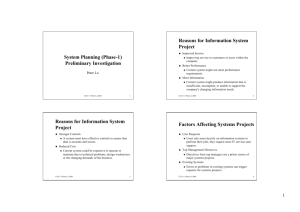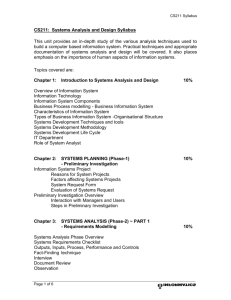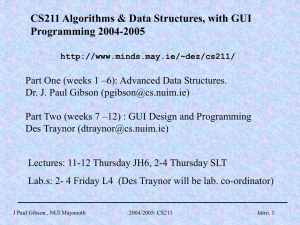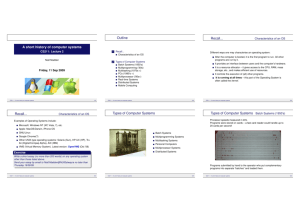User Interface, Input and Output Design
advertisement
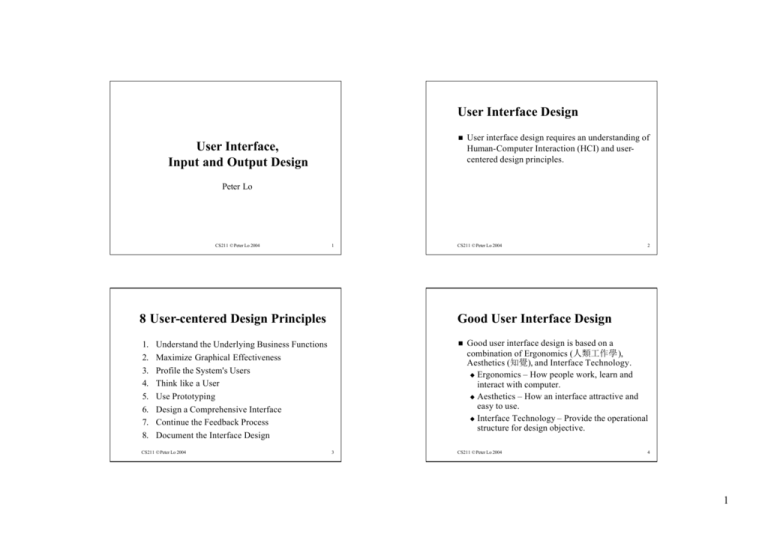
User Interface Design n User Interface, Input and Output Design User interface design requires an understanding of Human-Computer Interaction (HCI) and usercentered design principles. Peter Lo CS211 © Peter Lo 2004 1 8 User-centered Design Principles 1. 2. 3. 4. 5. 6. 7. 8. 2 Good User Interface Design n Understand the Underlying Business Functions Maximize Graphical Effectiveness Profile the System's Users Think like a User Use Prototyping Design a Comprehensive Interface Continue the Feedback Process Document the Interface Design CS211 © Peter Lo 2004 CS211 © Peter Lo 2004 3 Good user interface design is based on a combination of Ergonomics (人類工作學), Aesthetics (知覺), and Interface Technology. u Ergonomics – How people work, learn and interact with computer. u Aesthetics – How an interface attractive and easy to use. u Interface Technology – Provide the operational structure for design objective. CS211 © Peter Lo 2004 4 1 User Interface Design Guidelines n n n n Focus on Basic Objectives Build an Interface that is Easy to Learn and Use Provide Features that Promote Efficiency Make it Easy for Users to Obtain Help or Correct Errors n Minimize Input Data Problems Provide Feedback to Users Create an Attractive Layout and Design n Use Familiar Terms and Images n n User Interface Controls CS211 © Peter Lo 2004 n 5 User Interface Controls CS211 © Peter Lo 2004 6 Input Design Issues n n CS211 © Peter Lo 2004 The designer can include many control features, such as Menu Bars, Toolbars, Dialog Boxes, Text Boxes, Toggle Buttons, List Boxes, Scroll Bars, Drop-down List Boxes, Option Buttons, Check Boxes, Command Buttons, Spin Bars, and Calendars among others. 7 Data Capture is the identification and recording of source data. Data Entry is the process of converting source data into computer-readable form and entering it into the information system. CS211 © Peter Lo 2004 8 2 6 Main Input Design Objectives 1. 2. 3. 4. 5. 6. Input and Data Entry Methods n Select a suitable input and data entry method Reduce input volume Design attractive data entry screens Use validation checks to reduce input errors Design required source documents Develop effective input controls CS211 © Peter Lo 2004 n Input processes should be efficient, timely and logical. Two major input methods: u Batch Input t Data entry is performed on a specified time schedule, such as daily, weekly, monthly, or longer. u Online Input t 9 Offers major advantages, including the immediate validation and availability of data. CS211 © Peter Lo 2004 Input Volume Data Entry Screens Design n n n To reduce input volume, you must reduce the number of data items required for each transaction. Guidelines: u Input necessary data only. u Do not input data that the user can retrieve from system files or calculate from other data. u Do not input constant data. u Use codes. CS211 © Peter Lo 2004 11 n n n n n n n 10 Restrict user access. Provide a descriptive caption. Display a sample format Require ending keystroke for every field. Do not require users to type leading zeroes for numeric fields. Do not require users to type trailing zeroes for numbers that include decimals. Display default values. Use a default value when a field value will be constant. CS211 © Peter Lo 2004 12 3 Data Entry Screens Design n n n n n n n Input Errors Validation Display list of acceptable values. Provide a way to leave the data entry screen at any time. Provide users with an opportunity to confirm the accuracy of input data before entering it Provide a means for users to move among fields on the form in a standard order or in any order they choose. Design the screen form layout to match the layout of the source document. Allow users to add, change, delete, and view records. Provide a method to allow users to search for specific information. CS211 © Peter Lo 2004 13 n n Reducing the number of input errors improves data quality. Some data validation checks: u Sequence checks. u Existence checks. u Data type checks. u Range checks. u Reasonableness checks. u Validity checks. u Combination checks. u Batch controls. CS211 © Peter Lo 2004 Source Documents Design Input Control n n A source document is a form used to request and collect input data, trigger or authorize an input action, and provide a record of the original transaction. Input control includes the necessary measures to ensure that input data is correct, completed and secure. u Audit trail Records the source of each data item and when it entered the system. Show how and when data is accessed or changed, and by whom. Data security t Protects data from lost or damage and recovers data when it is lost or damaged. t u CS211 © Peter Lo 2004 14 15 CS211 © Peter Lo 2004 16 4 Output Design Issues n Types of Output Some questions to consider before designing output: u What is the purpose of the output? u Who wants the information, why it is needed, and how will it be uses? u What specific information will be included? u Will the output be printed, viewed on-screen, or both? u u n n n n n Internet-Based Information Delivery. E-Mail. Audio Output. Automated Facsimile Systems. Computer Output Microfilm (COM). When will the information be provided, and how often must it be updated? Do security or confidentiality issues exist? CS211 © Peter Lo 2004 17 CS211 © Peter Lo 2004 Specialized Forms Of Output Printed Output n n n n n n n Retail point-of-sale terminals Automated teller machines (ATM) Special-purpose printers Plotters Digitized photos Programmable devices n Detail Report u A detail report produces one or more lines of output for each record processed. Each line of output printed is called a detail line. Exception Report n An exception report displays only those records that meet a specific condition or conditions. Summary Report u u CS211 © Peter Lo 2004 18 19 Upper-level managers often want to see total figure and do not need supporting details. CS211 © Peter Lo 2004 20 5 Detailed Report Exception Report n n Lists one record per line n CS211 © Peter Lo 2004 21 Summary Report n n CS211 © Peter Lo 2004 22 User Involvement Consolidates data, so you can review it quickly and easily Usually has totals, tables, or graphs CS211 © Peter Lo 2004 Identifies data outside of normal condition Conditions, called exception criteria, define normal activity or status range 23 n When designing a report, you should prepare a mock-up, or prototype, for users to review. CS211 © Peter Lo 2004 24 6 Report Design Principles n n n Printed reports must be attractive, professional, and easy to read. Good report design, like any other aspect of the user interface, requires effort and attention to detail. To produce a well-designed report, the analyst must consider several topics, including Report Headers and Footers, Page Headers and Footers, Column Headings and Alignment, Column Spacing, Field Order, and grouping of detail lines. CS211 © Peter Lo 2004 25 CS211 © Peter Lo 2004 Printing Volume and Time Requirements Measurement n n Efficient printing operations, timely delivery of finished reports, and accurate forecasts of paper and storage needs all depend on accurate estimates of print volumes and times. CS211 © Peter Lo 2004 27 n 26 Length Calculations u After completing a report design, it is important to estimate the length of the printed output. Time Calculations u You also can estimate the time required to print the report. CS211 © Peter Lo 2004 28 7 CS211 © Peter Lo 2004 29 CS211 © Peter Lo 2004 Output Control and Security Output Security Control n n Output must be accurate, complete, current, and secure. Companies use various output control methods to maintain output integrity and security. n n n n CS211 © Peter Lo 2004 31 30 Limit the number printed copies. Use a tracking procedure to account for each copy. Output is delivered to authorized recipients only. All sensitive reports should be stored in secure areas. All pages of confidential reports should be labeled appropriately. CS211 © Peter Lo 2004 32 8
